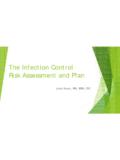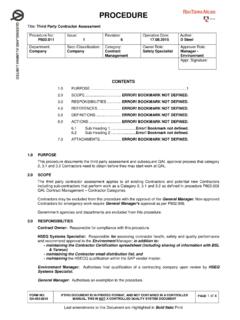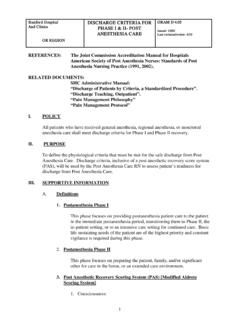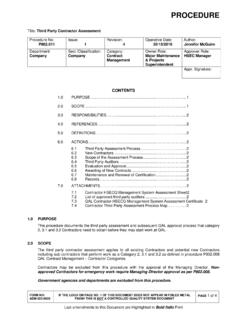Transcription of PROFESSIONAL STANDARDS OF PRACTICE - NZATS
1 PROFESSIONAL STANDARDS OF PRACTICE NZATS PROFESSIONAL STANDARDS of Practise Reviewed: June 2012 2 Index Page Introduction .. 3 Definition .. 4 Standard 5 Standard Two .. 6 Standard Three .. 7 Standard Four .. 8 - 9 Appendix A: STANDARDS on Infection Control .. 10 - 13 Appendix B: Supporting Guidelines .. 14 References and Recommended Reading .. 15 - 16 NZATS PROFESSIONAL STANDARDS of Practise Reviewed: June 2012 3 Introduction The New Zealand Anaesthetic Technicians Society Incorporated ( NZATS ) has prepared the following PROFESSIONAL STANDARDS of PRACTICE . Although the original emphasis of the Anaesthetic Technician s role was equipment-focused, this role has now evolved into a highly patient-orientated service.
2 Also, with changes such as inclusion of electronics in anaesthetic machines and in both invasive and non-invasive monitoring, the use of physiological computers and point of care testing equipment, the boundaries of knowledge and skills have been further extended. The Anaesthetic Technician is an integral member of the peri-operative team. As well as working in partnership with the Anaesthetist, the Anaesthetic Technician works with, and relates to, the surgical and nursing teams and auxiliary health care workers. Technicians must also work within their own team Anaesthetic Technicians - and support each other to carry out responsibilities that will ensure the best outcome for their patients and their service.
3 In many hospitals throughout New Zealand, Anaesthetic Technicians assist nursing staff in confirming pre-operative check-in and anaesthetic consent. Anaesthetic Technicians will also assist with intra-operative positioning and provide assistance to the surgical team as required. The scope of anaesthetic PRACTICE extends beyond the operating suite. Anaesthetic Technicians are required to provide support to the Anaesthetist in investigative and procedural units such as radiology, magnetic resonance imaging, angiography, transport, emergency departments and intensive care units. It is the responsibility of all Anaesthetic Technicians that they base their PRACTICE on the policies and clinical PRACTICE documentation of their departments.
4 As well, NZATS recommend that Anaesthetic Technicians base their PRACTICE on the guidelines of the Australian and New Zealand College of Anaesthetists (ANZCA) PS 8 document, see appendix B. NZATS promotes the quality and safety of patient care therefore supporting a 1:1 ratio of Anaesthetic Assistance for every case where anaesthesia is administered. Anaesthetic Technicians must take ownership for quality assurance initiatives relevant to their role and responsibilities. They should research, develop and review clinical PRACTICE documentation and ensure PRACTICE is evidence based. Therefore it is essential that Anaesthetic Technicians have PROFESSIONAL STANDARDS of PRACTICE which will provide them, their team members, and their employing hospitals, with a measure of the expectations recommended by NZATS .
5 The PROFESSIONAL STANDARDS of PRACTICE stated in this document reflect the wide range and variety of settings in which Anaesthetic Technicians may PRACTICE with in the New Zealand health-care system. NZATS PROFESSIONAL STANDARDS of Practise Reviewed: June 2012 4 Key stakeholders for the service of Anaesthetic Technicians are: Medical Sciences Council of New Zealand Hospitals providing surgical services throughout New Zealand New Zealand Anaesthetic Technicians Society Inc. NZATS approved training hospitals throughout NZ Australian and New Zealand College of Anaesthetists New Zealand Society of Anaesthetists Clinical Training Agency Ministry of Health Nursing Council of New Zealand New Zealand Nurses Organisation (NZNO) Peri-operative College of NZNO.
6 STANDARDS of PRACTICE prepared and documented by: Janine Gunn (NZ Reg. Nurse, NZ Reg. Anaesthetic Technician) Patricia O Brien (NZ Reg. Nurse, NZ Reg. Anaesthetic Technician) Christine Minton (NZ Reg. Nurse, NZ Reg. Anaesthetic Technician) STANDARDS of Infection Control prepared and documented by: Dr. Andrew Warmington (BHB MBChB FANZCA) DEFINITION What is a standard? A standard is a desired and achievable level of performance against which actual performance can be measured. The STANDARDS make clear what the profession expects of its members. These are generic STANDARDS and are to provide the basis for all Anaesthetic Technicians to develop STANDARDS and policies specific to their workplace.
7 Standard One: Professionalism Standard Two: Scope of PRACTICE Standard Three: PROFESSIONAL Development Standard Four: Roles and Responsibilities NZATS PROFESSIONAL STANDARDS of Practise Reviewed: June 2012 5 STANDARD ONE: Anaesthetic Technicians are accountable for their PRACTICE and will promote equality for all. Objectives 1a. To comply with the Code of Health and Disability Services Consumers Rights. 1b. To incorporate the Treaty of Waitangi into all aspects of the workplace. 1c. To recognise and incorporate into daily work practices the diverse cultural needs of the community, individual beliefs and identity. Process 1a. Anaesthetic Technicians will be educated to, and will PRACTICE according to authorised ethical codes.
8 These include Codes of Ethics and Patients Code of Rights contained in the Health and Disability Service Act. 1b. Anaesthetic Technicians will be educated and will PRACTICE according to the principles of the Treaty of Waitangi and will be encouraged to attend cultural study days. 1c. Anaesthetic Technicians will have the resources readily available to recognise the diverse cultural needs and the personal beliefs of their clients. Anaesthetic Technicians will adjust their PRACTICE to reflect this. Outcomes 1a. Patients will be informed of their rights and be able to exercise these rights and choices and decisions made will be treated with respect. Patient and staff confidentiality and privacy will be maintained at all times.
9 Services will be provided in a manner that respects the dignity and individuality of the person concerned. 1b. Anaesthetic Technicians PRACTICE within the principles of the Treaty of Waitangi - Protection, Partnership and Participation. PRACTICE will be adjusted where possible to enable the patient to feel culturally and spiritually respected. Staff will work in partnership with local Iwi to ensure culturally safe PRACTICE . 1c. Anaesthetic care is provided in a non-judgemental, skilled manner that incorporates patients individual, cultural, racial and religious needs. NZATS PROFESSIONAL STANDARDS of Practise Reviewed: June 2012 6 STANDARD TWO: Anaesthetic Technicians are, within their scope of PRACTICE , responsible for the safety of their patients and colleagues.
10 Objectives 2a. To provide a PRACTICE that protects patients from physical danger and avoidable risk. 2b. To provide PRACTICE that is safe, legal and that meets the Australian New Zealand College Of Anaesthetists (ANZCA) guidelines, the New Zealand Anaesthetic Technicians Society Inc. ( NZATS ) and the Health Workforce funding agency (HWNZ). 2c. To provide a process that enables continuous evaluation of practices to provide safe outcomes for both patients and staff. 2d. To fully participate in the process of quality assurance. Process 2a. i) Anaesthetic Technicians will become familiar with, and participate in, the development of the Health and Safety, Infection Control manuals/policies and Quality Assurance programmes in their workplace.





